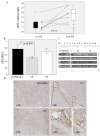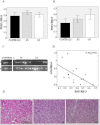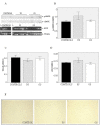Regional evidence of modulation of cardiac adiponectin level in dilated cardiomyopathy: pilot study in a porcine animal model
- PMID: 23164042
- PMCID: PMC3537584
- DOI: 10.1186/1475-2840-11-143
Regional evidence of modulation of cardiac adiponectin level in dilated cardiomyopathy: pilot study in a porcine animal model
Abstract
Background: The role of systemic and myocardial adiponectin (ADN) in dilated cardiomyopathy is still debated. We tested the regulation of both systemic and myocardial ADN and the relationship with AMP-activated protein kinase (AMPK) activity in a swine model of non-ischemic dilated cardiomyopathy.
Methods and results: Cardiac tissue was collected from seven instrumented adult male minipigs by pacing the left ventricular (LV) free wall (180 beats/min, 3 weeks), both from pacing (PS) and opposite sites (OS), and from five controls. Circulating ADN levels were inversely related to global and regional cardiac function. Myocardial ADN in PS was down-regulated compared to control (p < 0.05), yet ADN receptor 1 was significantly up-regulated (p < 0.05). No modifications of AMPK were observed in either region of the failing heart. Similarly, myocardial mRNA levels of PPARγ, PPARα, TNFα, iNOS were unchanged compared to controls.
Conclusions: Paradoxically, circulating ADN did not show any cardioprotective effect, confirming its role as negative prognostic biomarker of heart failure. Myocardial ADN was reduced in PS compared to control in an AMPK-independent fashion, suggesting the occurrence of novel mechanisms by which reduced cardiac ADN levels may regionally mediate the decline of cardiac function.
Figures




Similar articles
-
Pacing-induced regional differences in adenosine receptors mRNA expression in a swine model of dilated cardiomyopathy.PLoS One. 2012;7(10):e47011. doi: 10.1371/journal.pone.0047011. Epub 2012 Oct 12. PLoS One. 2012. PMID: 23071699 Free PMC article.
-
A slow-releasing form of prostacyclin agonist (ONO1301SR) enhances endogenous secretion of multiple cardiotherapeutic cytokines and improves cardiac function in a rapid-pacing-induced model of canine heart failure.J Thorac Cardiovasc Surg. 2013 Aug;146(2):413-21. doi: 10.1016/j.jtcvs.2012.10.003. Epub 2013 Mar 28. J Thorac Cardiovasc Surg. 2013. PMID: 23541854
-
Inducible NO synthase is constitutively expressed in porcine myocardium and its level decreases along with tachycardia-induced heart failure.Cardiovasc Pathol. 2016 Jan-Feb;25(1):3-11. doi: 10.1016/j.carpath.2015.08.003. Epub 2015 Aug 12. Cardiovasc Pathol. 2016. PMID: 26361649
-
Myocardial matrix degradation and metalloproteinase activation in the failing heart: a potential therapeutic target.Cardiovasc Res. 2000 May;46(2):225-38. doi: 10.1016/s0008-6363(99)00431-9. Cardiovasc Res. 2000. PMID: 10773226 Review.
-
Up- and down-regulation of adiponectin expression and multimerization: mechanisms and therapeutic implication.Biochimie. 2012 Oct;94(10):2126-30. doi: 10.1016/j.biochi.2012.01.008. Epub 2012 Feb 10. Biochimie. 2012. PMID: 22342903 Free PMC article. Review.
Cited by
-
Changes in adiponectin system after ventricular assist device in pediatric heart failure.JHLT Open. 2024 Feb;3:None. doi: 10.1016/j.jhlto.2023.100041. JHLT Open. 2024. PMID: 38357297 Free PMC article.
-
Adiponectin up-regulates the decrease of myocardial autophagic flux induced by β1 -adrenergic receptor autoantibody partly dependent on AMPK.J Cell Mol Med. 2021 Sep;25(17):8464-8478. doi: 10.1111/jcmm.16807. Epub 2021 Jul 29. J Cell Mol Med. 2021. PMID: 34322993 Free PMC article.
-
The Role of Cardiac T-Cadherin in the Indicating Heart Failure Severity of Patients with Non-Ischemic Dilated Cardiomyopathy.Medicina (Kaunas). 2020 Jan 9;56(1):27. doi: 10.3390/medicina56010027. Medicina (Kaunas). 2020. PMID: 31936691 Free PMC article.
-
Urinary adiponectin concentration is positively associated with micro- and macro-vascular complications.Cardiovasc Diabetol. 2013 Sep 28;12:137. doi: 10.1186/1475-2840-12-137. Cardiovasc Diabetol. 2013. PMID: 24073643 Free PMC article.
-
Adiponectin: a manifold therapeutic target for metabolic syndrome, diabetes, and coronary disease?Cardiovasc Diabetol. 2014 Jun 23;13:103. doi: 10.1186/1475-2840-13-103. Cardiovasc Diabetol. 2014. PMID: 24957699 Free PMC article. Review.
References
-
- Ding G, Qin Q, He N, Francis-David SC, Hou J, Liu J, Ricks E, Yang Q. Adiponectin and its receptors are expressed in adult ventricular cardiomyocytes and upregulated by activation of peroxisome proliferator-activated receptor gamma. J Mol Cell Cardiol. 2007;43:73–84. doi: 10.1016/j.yjmcc.2007.04.014. - DOI - PMC - PubMed
Publication types
MeSH terms
Substances
LinkOut - more resources
Full Text Sources
Medical
Miscellaneous

